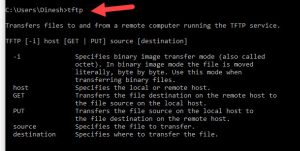

- #Tftp client windows command dd wrt update#
- #Tftp client windows command dd wrt password#
- #Tftp client windows command dd wrt download#
- #Tftp client windows command dd wrt mac#
#Tftp client windows command dd wrt mac#
On your Mac for example, go to “ System Preferences” “ Network“, choose your “ Wi-Fi” adapter and click “ Advanced” (lower right corner). This could be necessary for all your Wi-Fi connected devices, like phones, tablets, etc. On the other hand cheap “Made in China” IP camera’s had not noticed the difference. For example, my Mac does not seem to appreciate the change so the “remembered” Wi-Fi connections should be deleted and re-detected.
#Tftp client windows command dd wrt password#
Since I have my lazy moments, I use the same Wi-Fi SSID and password for either firmwares, which can cause issue on your computer. I was unable to find a clear list of limitations or advantages for one domain over another (seems that Australia and Europe provide a better signal than United States, but that could also just be coincidence).Īdditional Tips Flushing Previously detected Wi-Fi networks The default settings will work just fine, but you can do some tweaking here, and you might want to set the “ Regulatory Domain” to you area/country to make sure your equipment is not breaking any laws … or maybe to do exactly that and boost your signals or channels used a little. Under “ Wireless” “ Basic Settings” you can verify your Wi-Fi settings. Step 7 – Basic Configuration Steps (Wi-Fi) – Amsterdam, Central European Standard Time (GMT+1) is UTC+01:00Ī commonly used NTP time server ( Server IP/Name) would be .Īfter having done all your settings click “ Apply Settings“. – USA, Central Time (GMT-6) is UTC-06:00. If you’re not sure about your timezone: check this website. Go to “ Advanced” “ Administration” “ Router Update” and click “ Browse” to select the downloaded DD-WRT firmware file and click “ Upload”.įor your “ Time Settings“, those not used to using the “UTC” time: UTC can be seen as a synonym for GMT. MacOS X: Go to “System Preferences” “Network” and choose your active network connection. Windows: type in a DOS box the command “ipconfig”. If this doesn’t work, look for the IP information of your network connection and copy the IP address mentioned there for the “ Default Gateway“.

It’s recommended to actually use the IP Address of your router and not the router name! Which should work, unless you really changed the default settings of your router’s LAN configuration. The default admin page for your router (a NetGear R7000) is: Go to the admin page of your router and login. Wiki How has a page that covers most browsers. It might not be needed, but it’s recommended by the developer of the DD-WRT firmware.įor Google Chrome, you can find it under the “File” menu (Windows) and for MacOS X under the “Chrome” menu.
#Tftp client windows command dd wrt download#
You can download the files I have used from Tweaking 4All, but with fast development of firmwares these days, I HIGHLY recommend using the two links in the list above.įlash the Initial version FIRST when you’re still running NetGear firmware!ĭownload - NetGear R7000 Stock Firmware Filename: – Download: Latest DD-WRT firmware for the R7000 – for all release check out Kong’s webpage – Download: Latest NetGear Stock R7000 Firmware It may not be a bad idea to print this guide either – just so you have it handy. chk files (you might have downloaded a zipped file, which you might want to unzip first).
#Tftp client windows command dd wrt update#
bin files can be used to update it to the latest build.īefore we start the flashing process, we first want to download the firmwares we would like to have available even when we have no Internet. chk file is needed for you first flash to DD-WRT, which is the “ initial” version you can download here.Īfter your router runs DD-WRT. Recently Kong changed the way he publishes new versions by using. I’d most certainly try that one right away when it becomes available! Note : There is at this time no Tomato Firmware available for the R7000, but maybe in the near future a R7000 version can be found at. – Wi-Fi connections occasionally “freeze”, but this could be my lack of experience …įor more details see also the DD-WRT Wiki and this article at FlashRouters. – Wi-Fi throughput is not as strong as Stock firmware (although you might not notice during daily use) With the current, very stable, version created and maintained by Kong, I’ve only found two weak points: – Scheduling for ethernet and both Wi-Fi bands, – Realtime graphs, monitoring traffic one ach network connection, – DNSMasq support (advanced DNS and DHCP functions), – VPN support (the Router will setup the VPN connection!), – Fine tuning of your Wi-Fi (channels, signal strength, etc), DD-WRT, due to it’s open source nature, comes with tons of functions you won’t find on commercial router firmware.


 0 kommentar(er)
0 kommentar(er)
